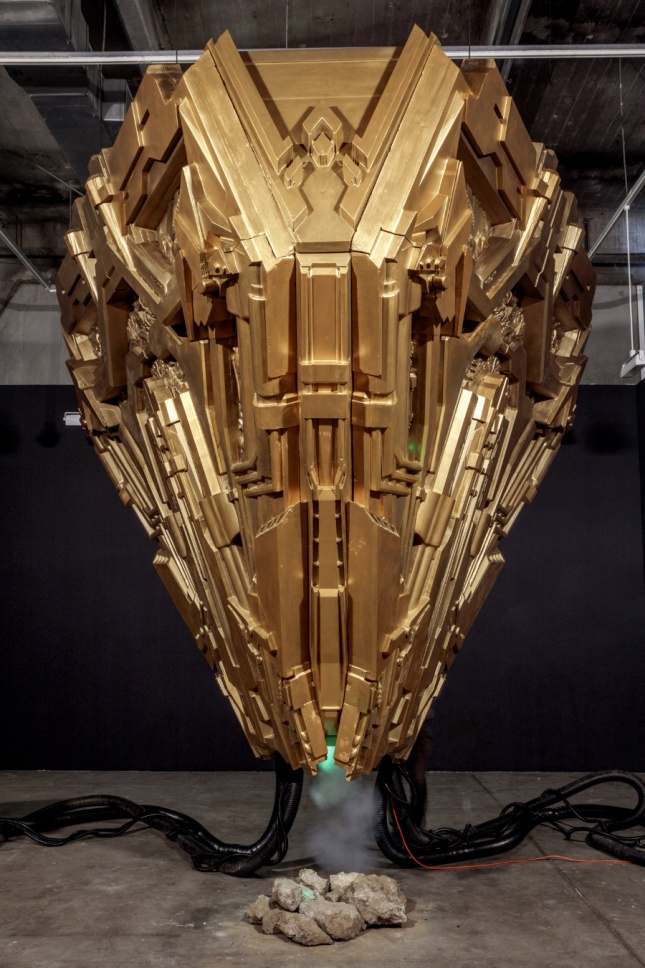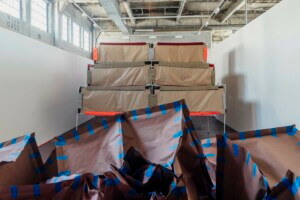In a recent installation at the Southern California Institute of Architecture (SCI-Arc), Mark Foster Gage Architects attempts to bring the notion of parafictional art fantasy to the realm of architecture—with mixed results.
Gage’s Geothermal Futures Lab considers the notion that, given the current regime of “fake news” and “post-truth” reality, architects might have renewed license to create new visions for the future rooted primarily in fantasy. In lectures and writings, Gage argues that architects from Vitruvius onward have always engaged in some form or another with parallel or alternate versions of reality through their works and that conditions are ripe today for this tendency to take hold once again. Furthermore, Gage posits that these efforts represent a facet of the Object-Oriented Ontology (OOO) school of thought and could potentially be used to fend off the ever-increasing erosion—or flattening—of a shared reality that occurs when the people who lead and represent the nation are fundamentally preoccupied with telling lies.
In the exhibition text, Gage asks, “Might architecture’s power in this new world be conducted through an elasticity of the real that encourages citizens to develop doubt about their presented realities—and therefore perhaps become more resistant to ‘fake news’ and ‘alternative facts?’”
For the installation, Gage seizes this opportunity as a justification for postulating a new energy-generation technology called “laser ablation geothermal resonance” that draws its power from sources deep below the surface of the earth in order to sustainably supply Los Angeles with over two-thirds of its daily energy needs. To convey the fundamentals of this fictional energy revolution, Gage fills the SCI-Arc gallery with a stage setting meant to approximate a control center for the power generator, installing lab equipment, a metal detector, a faceted gold-leaf-covered reactor, a pile of rocks, and a collection of high-powered lasers and imaginary technical drawings for display.

Technically speaking, the student-produced machine drawings are exquisite in their effusive and cheeky detail. Drawn to convey exploded axonometric views of the reactor and other components, the starkly outlined assemblage drawings also incorporate recognizable pop cultural elements, with hidden My Little Pony and Mr. Potato Head figurines buried within the constructions. The reactor mock-up is impressive in its detailing as well; it features the fractal and agglomerated geometries Gage’s other academic work is known for, while spewing fog from its lower extremity.
But overall, the exhibition—and Gage’s interpretation of what parafictional fantasy in the era of “fake news” can provide to the field of architecture—falls flat.
It’s not the physical objects that result from Gage’s exploration that are in question, but rather the interpretations that underlie them. For one, it belies a fundamental misreading of the current political-cultural moment to describe the Trumpian notion of “fake news” as a symptom of the so-called “great flattening” of intellectual hierarchies OOO represents. Practically speaking, “fake news” is not so much a product of the erosion of objective truth as much as it is an acknowledgment of multiple, covalent, and oftentimes contradictory perspectives that have always existed. Like it or not, “fake news” represents not merely plurality, but a new era of simultaneity writ large. The president and his lackeys have not so much created a fantasy world for their devotees to occupy as elevated a parallel existence that has always been very real to its adherents.
In a lecture supporting the exhibition, Gage cites the Black Lives Matter and #MeToo movements as emblematic of “flattening” as well, a comparison that also doesn’t really apply. If OOO ideology is rooted in the “removal of human as primary subject” from perceived reality, how can two movements entirely rooted in acknowledging and prioritizing the fundamental humanity and agency of two often-maligned social groups serve as a case study? The comparison is flawed and problematic, representing a misunderstanding of not just what drives these movements, but also of what we can learn from them as architects, as well.
And lastly, like so many other recent attempts at projecting future scenarios, the project is not really “speculative” in the literal sense and represents merely an intensification of existing modes and technologies, raising the question: If architecture’s power right now lies in its ability to speculate, what does it mean to have so many of its fantasies seem so underwhelmingly conventional?
Southern California Institute of Architecture
January 26 through March 4











